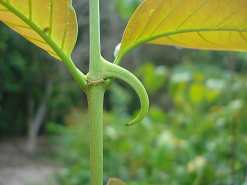Cat’s Claw
- Cat’s claw is a plant. Two species of cat’s claw, Uncaria tomentosa and Uncaria guianensis, are of primary interest for use as medicine.Cat’s claw grows wild in many countries of Central and South America, especially in the Amazon rain-forest. Uncaria tomentosa is most commonly used in the U.S., and Uncaria guianensis is typically used in Europe. Medicine is made from the root and bark. Cat’s claw was ranked as the seventh most popular herb in U.S. sales in 1997. Be careful not to confuse cat’s claw with cat’s foot.
Contents
Uses
- The use of this woody vine dates back to the Inca civilization. Historically, cat’s claw has been used for centuries in South America to prevent and treat disease.
- Cat’s claw has been used as a folk or traditional remedy for a variety of health conditions, including viral infections (such as herpes and HIV), Alzheimer’s disease, cancer, and arthritis.
- Other folk uses include supporting the immune system and promoting kidney health, as well as preventing and aborting pregnancy.
- The inner bark of cat’s claw is used to make liquid extracts, capsules, and teas. Preparations of cat’s claw can also be applied to the skin.
- Cat’s claw is most commonly used for improving symptoms of both osteoarthritis and rheumatoid arthritis.
- It is also used for various digestive system disorders including swelling and pain (inflammation) of the large intestine (diverticulitis), inflammation of the lower bowel (colitis), inflammation of the lining of the stomach (gastritis), stomach ulcers, hemorrhoids, and leaky bowel syndrome.
- Some people use cat’s claw for viral infections including shingles (caused by herpeszoster), cold sores (caused by herpes simplex), and AIDS (caused by human immunodeficiency virus (HIV)).
- Cat’s claw is also used for chronic fatigue syndrome (CFS), wound healing, parasites, Alzheimer’s disease, asthma, hay fever, cancer (especially urinary tract cancer), a particular type of brain cancer called glioblastoma, gonorrhea, dysentery, birth control, bone pains, and “cleansing” the kidneys.
Benefits
- Small studies in humans have shown a possible benefit of cat’s claw in osteoarthritis and rheumatoid arthritis, but no large trials have been done. In laboratory studies, cat’s claw stimulates part of the immune system, but it has not been proven to reduce inflammation or boost the immune system in humans.
- The National Institute on Aging funded a study that looked at how cat’s claw may affect the brain. Findings may point to new avenues for research in Alzheimer’s disease treatment.
Cautions
- Few side effects have been reported for cat’s claw when it is taken at recommended dosages. Though rare, side effects may include headaches, dizziness, and vomiting.
- Women who are pregnant or trying to become pregnant should avoid using cat’s claw because of its past use for preventing and aborting pregnancy.
- Because cat’s claw may stimulate the immune system, it is unclear whether the herb is safe for people with conditions affecting the immune system.
- Cat’s claw may interfere with controlling blood pressure during or after surgery.
Other Names
Griffe du Chat, Liane du Pérou, Life-giving Vine of Peru, Samento, Uña de Gato, Uncaria guianensis, Uncaria tomentosa.
References
- Source: WebMD, “Cat’s Claw”, web article, www.webmd.com/vitamins-supplements/

